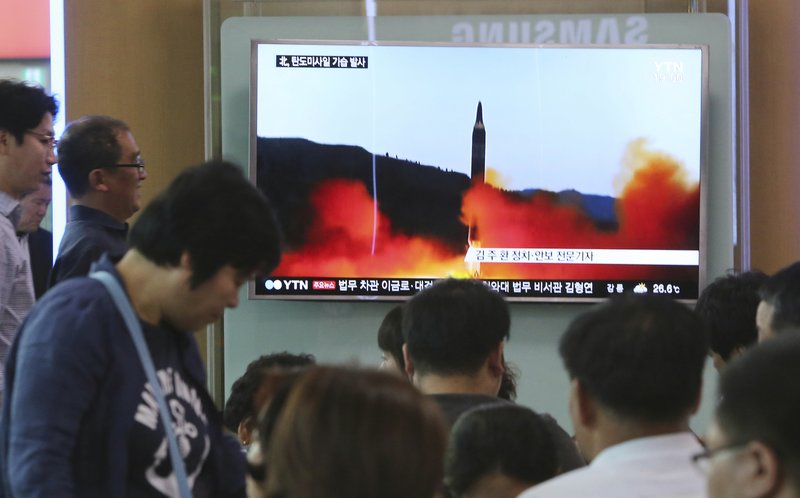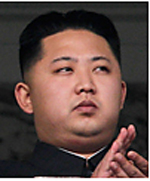SEOUL, South Korea -- North Korea fired a solid-fuel ballistic missile Sunday that can be harder for outsiders to detect before launch and later said the test was hailed as perfect by leader Kim Jong Un.
The official Korean Central News Agency confirmed today that the missile was a Pukguksong-2, a medium- to long-range ballistic missile also launched in February. South Korea and the U.S. had earlier described Sunday's missile as medium-range.
The Pukguksong (Polaris)-2 is a land-based version of a submarine-launched missile. The missile advances North Korea's weapons capabilities because solid-fuel missiles can be fired faster and more secretly than those using liquid fuel, which must be added separately and transported to a launch site using trucks that can be seen by satellites.
The rocket was fired from an area near the North Korean county of Pukchang, in South Phyongan province, and flew eastward about 310 miles, South Korea's Joint Chiefs of Staff said. The U.S. Pacific Command said it tracked the missile before it fell into the sea.
The news agency said the test was intended to verify technical indexes of the weapon system and examine its adaptability under various battle conditions before deployment to military units. Kim ordered the launch from an observation post and approved its deployment after analyzing the results with officials and finding them perfect, the state news agency said.
White House officials traveling in Saudi Arabia with President Donald Trump said the system that was tested had a shorter range than the missiles fired in North Korea's most recent tests.
The missile appeared to be similar in range and maximum altitude to the missile that North Korea test-fired in February, the South Korean Joint Chiefs official said. The missile launched on Sunday reached an altitude of 350 miles, said the official, who spoke on condition of anonymity, citing office rules.
The February test involved using a launch truck to fire a solid-fuel missile. That missile traveled about 350 miles before crashing into the sea, according to South Korean and U.S. officials.
The February launch, the North's first missile test after Trump took office, alarmed neighbors because of the harder-to-detect solid-fuel capability.
In an interview with Fox News Sunday, U.S. Secretary of State Rex Tillerson said it was too early to know whether diplomatic and economic pressures being exerted on the North Korean government are having an impact in the wake of the latest missile test.
"We're early in the stages of applying the economic pressure as well as the diplomatic pressure to the regime in North Korea," Tillerson said. "Hopefully they will get the message that the path of continuing their nuclear arms program is not a pathway to security or certainly prosperity. The ongoing testing is disappointing. It's disturbing."
South Korea's new president, Moon Jae-in, held a National Security Council meeting to discuss Sunday's launch, which came hours after he named his new foreign minister nominee and top advisers for security and foreign policy. He did not make a public statement after the meeting.
In Tokyo, Japanese Prime Minister Shinzo Abe called the launch a "challenge to the world" that tramples international efforts to resolve the North Korean nuclear and missile problems peacefully. He vowed to bring up the issue at this week's G-7 summit in Italy.
At the United Nations, diplomats from the U.S., Japan and South Korea said they requested a Security Council consultation on the missile test. The closed discussion will take place Tuesday. The diplomats spoke on condition of anonymity because the meeting had not been officially announced.
Under the watch of third-generation dictator Kim, North Korea has been pursuing a decadeslong goal of putting a nuclear warhead on an intercontinental ballistic missile capable of reaching the U.S. mainland.
Sunday's launch came a week after North Korea successfully tested a new mid-range missile that it said could carry a heavy nuclear warhead. Experts said that rocket flew higher and for a longer time than any other missile previously tested by North Korea, and that it could one day reach targets as far away as Hawaii and Alaska.
The ground-to-ground missile launched May 14, known as Hwasong-12, landed in the sea between the North and Japan, prompting angry comments from Trump, Moon and Abe.
The missile soared to an altitude of 1,312 miles before falling in open water about 480 miles from the launching site. It was believed to have a longer range than any other North Korean missile tested before.
Analysts said the missile looked like an intermediate-range ballistic missile that could fly far enough to target key U.S. military bases in the Pacific, including those in Guam.
The successful test drew keen attention in the region because its extended range indicated that the country was making progress toward building an intercontinental ballistic missile.
North Korea later claimed that the launch was in part to test the "re-entry" technology, which is needed to protect a warhead from the intense heat and vibration as a long-range missile crashes through the earth's atmosphere.
North Korea conducted two nuclear tests last year, possibly improving its ability to make nuclear weapons small enough to fit on long-range missiles. The country has also conducted a slew of rocket launches as it continues to advance its arsenal of ballistic weapons, which include mid-range solid-fuel missiles that could be fired from mobile land launchers or submarines.
If North Korea did indeed fire the Pukguksong-2 again, it might be part of attempts to stabilize the system before operationally deploying the missiles, said Kim Dong-yub, an analyst at Seoul's Institute for Far Eastern Studies.
Kim said there's also a possibility that the North is conducting engine tests and other experiments as it pushes for the development of a solid-fuel intercontinental ballistic missile that could potentially reach the U.S. mainland. If the North ever obtains a solid-fuel intercontinental ballistic missile, it would likely be a rocket powered by a cluster of several Pukguksong-2 engines, Kim said.
Missile tests such as Sunday's present a difficult challenge to Moon, a liberal who took over as South Korea's president on May 10 and has expressed a desire to reach out to the North. Pyongyang's aggressive push to improve its weapons program also makes it one of the most urgent foreign policy concerns for the Trump administration.
South Korea's Foreign Ministry said in a statement that the North's latest launch "throws cold water" on the expectations by Moon's government to "stabilize peace and denuclearize the Korean Peninsula."
Information for this article was contributed by Kim Tong-Hyung amd Edith M. Lederer of The Associated Press and Choe Sang-Hun of The New York Times.
A Section on 05/22/2017

